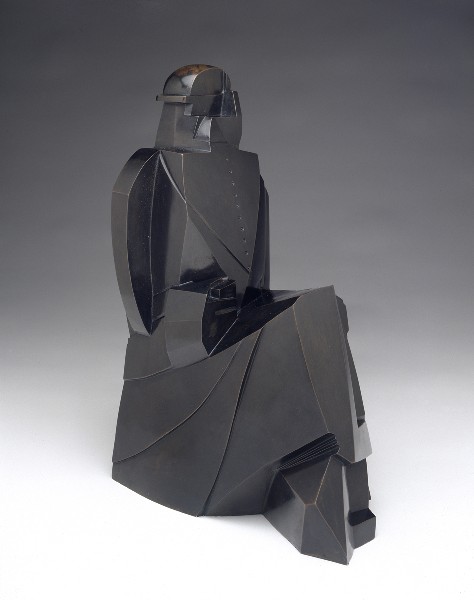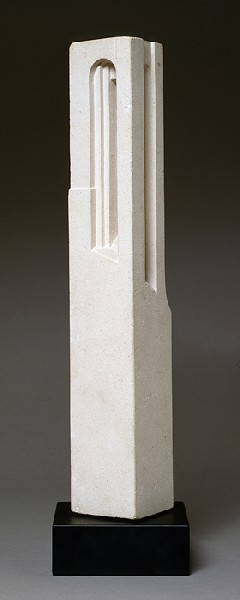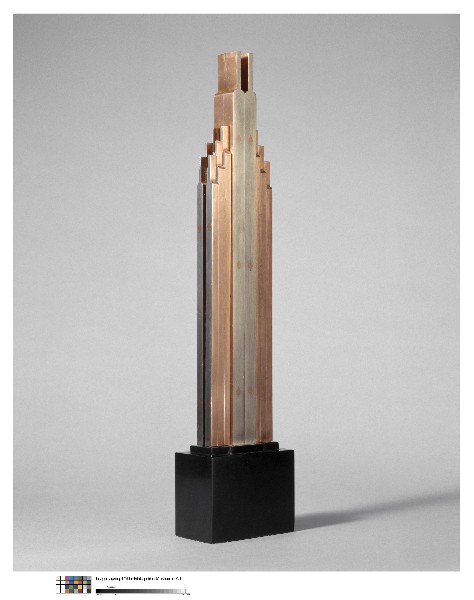John Storrs: Machine Age Modernist
Elegant Exhibit at Boston Athenaeum
By: Mark Favermann - Jun 21, 2010
John Storrs: Machine-Age Modernist
At The Boston Athenaeum
May 12—Sept. 3, 2010
The elegance of a Modernist pioneer is being eloquently presented at the Boston Athenaeum. This first major exhibition in over two decades of the works of sculptor John Storrs (American 1885-1956) focuses on the dynamic, highly abstract pieces that he completed between 1910 and 1930. For a while, Storrs was a student of Auguste Rodin.
Through his artistic vision, Storrs brought to America a new way to look at and philosophically consider three dimensional form refuting a previously academic medium that was stylistically chained to a classical language and a tired sense of historicism that defined and controlled American sculpture.
This show demonstrates a certain symmetry for the venerable Boston Athenaeum. Starting in the 1820s, the Boston Athenaeum formed Boston's earliest collection of casts and copies of antique sculpture. This significant collection became a study center and visual resource for artists. According to David Dearinger, the Susan B. Morse Curator of Paintings and Sculpture at the Boston Athenaeum, in his forward to the Storrs' show catalogue, "This country's first professional sculptor of international repute, Horatio Greenough, for example, came to the Athenaeum to study its casts as part of his artistic training.
"At the same time, the Athenaeum began collecting contemporary sculpture by both American and European artists, and by the the time of the Civil War, it owned over eighty examples in marble, bronze and plaster." Thus, the Storrs' exhibition, the first truly abstract sculpture by an American artist, book-ends the traditional, classical, rather staid and highly academic artworks that the Athenaeum collected for its first 80 years.
John Storrs is one of America's foremost modernists. He created a remarkable body of work that almost single-handedly infused vitality and vigor into the nation's rather academic and traditional medium. Living a great deal of time in France, his influence was felt in avant-garde artistic circles in Europe as well during the early decades of the Twentieth Century. Truly a pioneer American modernist sculptor, he was born in Chicago in 1885, the son of a prominent and wealthy Chicago developer and architect.
In 1905, he traveled to Berlin to study music, but soon decided to become a sculptor. He studied sculpting and developed techniques for working with various materials with prominent academics Lorado Taft at the Art Institute of Chicago and with Charles Grafly at the Pennsylvania Academy of Fine Arts. By 1911, he was living in Paris, where he studied with Auguste Rodin who considered him quite talented.
While in Paris, he also attended the Academie Julian. Gradually his style moved from representational sculpture and wood engravings to the machine-like sculptures for which he is best known.
In 1914, Storrs married the writer Marguerite Deville Chabrol. The couple divided their time between France and the United States. His inheritance mandated that he reside part time in the United States, but he preferred France. In the 1930s, Storrs generally stopped sculpting and turned to abstract painting that often suggested the human figure. Storrs was twice arrested and imprisoned by the German occupation forces during World War II.
After being released, he returned to his studio in Mer, France and worked there until his death in 1956. Though artistically productive until his death, what is considered his best and therefore most influential work are the pieces featured in the exhibition at the Boston Athenaeum, his abstract sculptures.
It is clear looking at these pieces that Storrs was influenced by the avant-garde art of Europe and the skyscraper architecture emerging in the United States, primarily in New York and his hometown of Chicago. Even small, about one to three feet high, his works suggests monumental structures, architectonic elements that soar. There is an elegance of line that suggests a nod to Frank Lloyd Wright's work as well.
Storrs pieces easily fit with Wright's aesthetic. Picasso's cubism can be seen in the more figurative pieces like The Abbott, but there is a restrained quality to Storrs work that does not suggest the exuberance of Picasso or Braque. However, there is a related vital visual geometry that marks the work as well.
There is a certain muscularity of form to each of Storrs' pieces in the exhibition. Though often rather minimalist in visual statement, his three dimensional forms evoke scale and strength. Rather than sculpture on pedestals, these sculptures suggest grand civic designs or public artworks. Many of his pieces are called Architectural Forms or Forms in Space. This deliberately states the artist's notion of what he considered important.
Another influence on his work may have been the emerging Art Deco styling of the period that would have been in evidence in and around Paris at the time. In turn, Storrs' work may have just as strongly influenced Art Deco styling. The premiere Art Deco furniture makers in Paris of the 20s, Ruhlmann and Laurent, purchased examples of his work to inspire the firm's own pieces. Ruhlmann furniture pieces are now among the most prized furniture of the period by collectors.
His more austere geometric pieces also reflect the work of Le Corbusier and his contemporaries who were rejecting all architectural decoration and thus anti-Modernist ornamentation. Referred to as Studies in Form, Storrs' stone pieces all have a quiet elegance with an inner strength. Rather than coldly wrought objects, these pieces visually voice abstraction somehow as a human language. From his writings John Storrs' Modernism was developed by him into a total aesthetic philosophy.
His circle of friends were some of those considered leaders of the European artistic avant-garde. These included Marcel Duchamp, Man Ray, Charles Demuth and Joseph Stella. Their aesthetic and humanistic conversations certainly informed Storrs' work and vice-versa.
There is a beauty and richness to his metal pieces as well. Storrs has joyously articulated a visually embracing variety of metal, form and color. This interplay of silhouette, shape and size underscored by tone, contrast and visual texture results in the essence of quality of each of Storrs' sculptures. The pleasure of all of his pieces-metal, stone or plaster, is the appealing wholeness of their crafted and aesthetic forms.
John Storrs' work strategically enlightened his contemporaries as well as future architecture, design and fine arts. This is an outstanding exhibition that should be a must see by artists, architects, designers and those who appreciate objects of beauty and visual quality.
The show was organized by the Athenaeum by guest curator Debra Bricker Balken who last year curated the provocative Dove/Okeeffe Exhibition at the Clarke Institute in Williamstown, MA. With a forward by David Dearinger, she wrote a thoughtful and beautifully illustrated catalogue for the exhibit as well.
According to Dr. Dearinger, this is the first art exhibit in the Boston Athenaeum's history that borrowed pieces from other museums and collections including the Hirshorn and the Metropolitan Museum of Art. The exhibition will travel to the Norton Gallery of Art in West Palm Beach, Florida and then to the Grey Art Gallery at New York University in New York.







